Found Family is one of my favorite themes across media. From Bridge Four in Sanderon’s Stormlight Archive to Tokyo Godfathers, possibly my single favorite animated movie of all time. Beautiful stories about coming together for who you are rather then who you were born to. It’s especially pervasive across anime, found in everything from action packed Shounen like One Piece to serious character dramas like Seirei no Moribito. And today, I’m here to talk to you about one more. An original series from the now defunct Studio Manglobe, and Sato Yamamato’s, since responsible for Yuri on Ice and The Woman Called Fujiko Mine, full length directorial debut, I give to you a Found Family story with a bit of Latin flair. That’s right, you clicked on the review already knowing what it was, so let’s dive right in to Michiko & Hatchin.
Be warned, this review contains minor unmarked spoilers for Michiko & Hatchin. It also contains major spoilers in some sections however these will be heavily marked to avoid accidents.
Production
As you might expect, the best place to start talking about an anime is, you guessed it, the animation. In this case though, Michiko & Hatchin’s animation isn’t what drew me to it. Oh it’s there, Michiko & Hatchin has some nice cuts. Not a lot mind you, and most of what it does have is back loaded in my opinion. But Takafumi Hori has some spectacular background work, and Naoyuki Asano has a fantastically trippy sequence near the middle, just to name a few. Overall though, I would say Michiko & Hatchin is a very inconsistently animated show, and that anyone going into it for some criminal hijinks and action might want to temper their expectations a bit. No, what really caught my interest about the show were the backgrounds, and the work done by the Director of Photography, Kazuhiro Yamada, and his team.
To say Michiko and Hatchin’s backgrounds are beautiful would be an understatement. It’s been a long time since I’ve seen a setting so fully and wonderfully realized entirely through its background art. I don’t just mean the level of detail or coloring, though those are nice and certainly contribute to the effect. More how they feel like truly living, breathing locations. The wall’s of an old church aren’t just brown and dirty, the paint is chipping and the tiles cracked. A city street is bright and colorful, covered in graffiti and the faded colors of a more vibrant time. The countryside, poor yet far away from the troubles of the crime-ridden cities, shows simple homes and beautiful vistas untouched by industry. All of it done so consistently that I never once doubted they belonged in the same world together. Truly, the backgrounds are where Michiko & Hatchin’s production shines.
Here are a few backgrounds for you to peruse through before you continue on, spoilered to avoid clogging up a bunch of space. Don’t worry, there are no story spoilers in here.
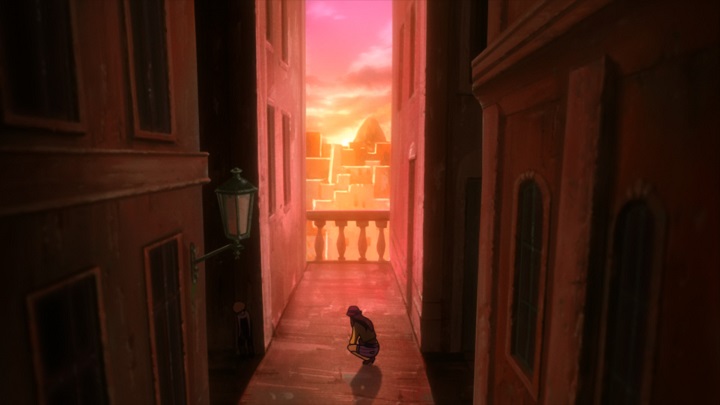
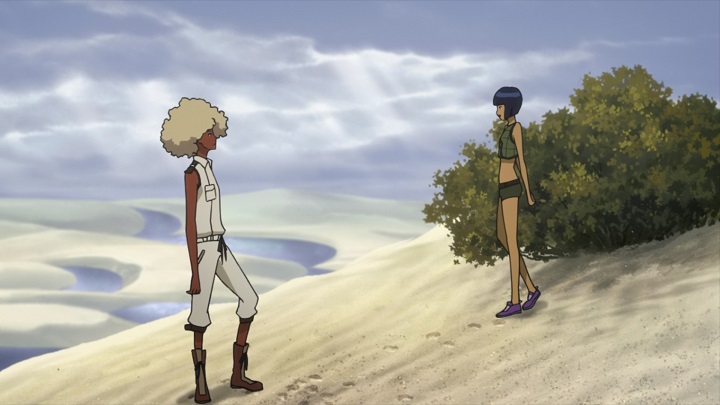
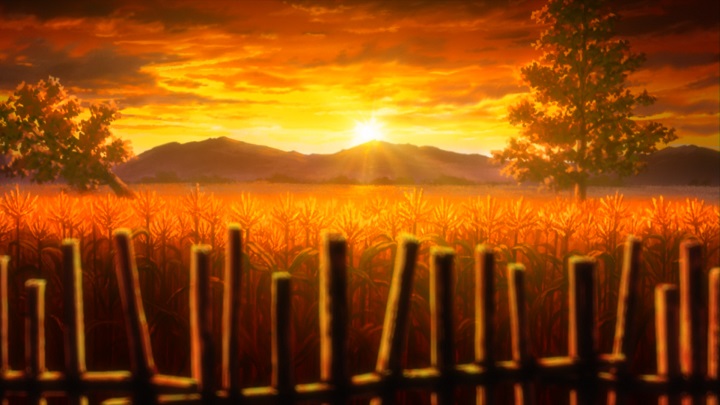
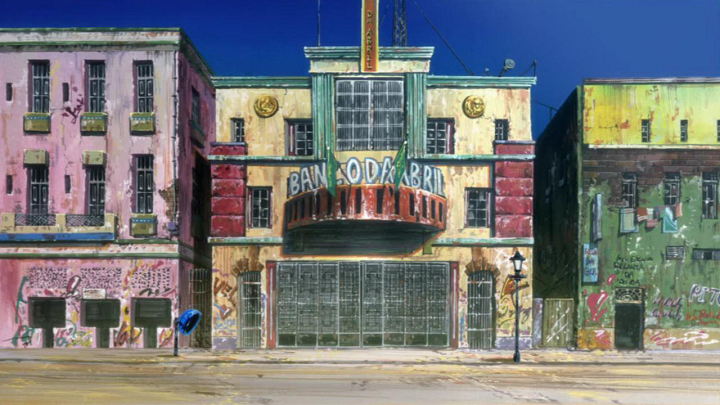
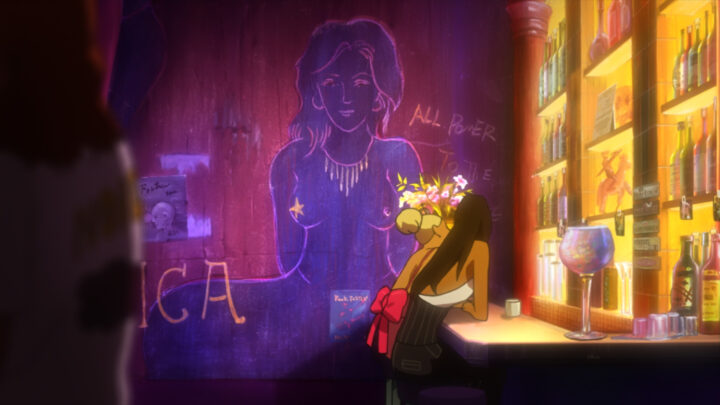
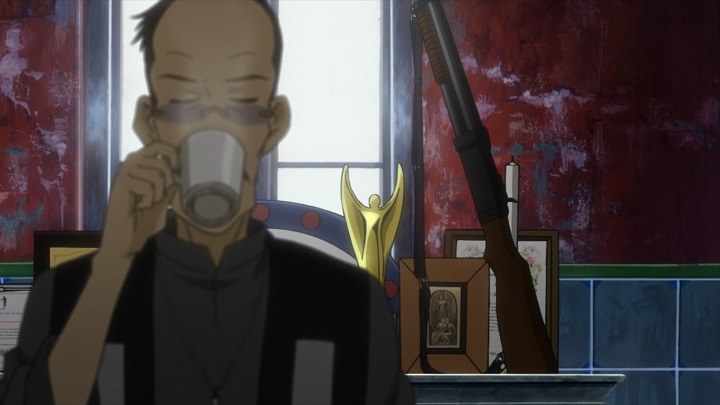
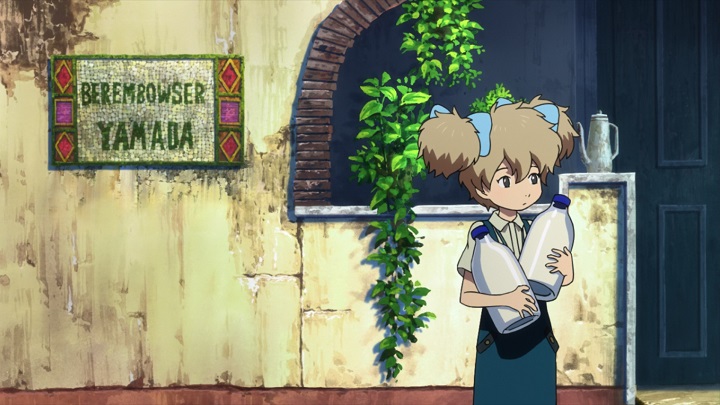
These beautiful backgrounds wouldn’t be enough on their own however without Sayo Yamamoto’s smart direction however. She makes the best use of Michiko & Hatchin’s animation and backgrounds, producing scenes like the one above on the regular. Using a television in the background playing an old movie to emphasize Michiko’s confident stride. The barrels of guns to direct our attention. A sloping hill to allow two characters of different heights to meet at eye level for a conversation. None of these are truly new or even innovative. But in a medium that so often see’s the most bare-bones schlock peddled out season after season, seeing someone actually care is nice. I won’t act like it’s perfect, it’s not. This is her first time directing an entire show. But you can see so much of what her style will become here, it’s truly a joy.
All in all, Michiko & Hatchin has what I would call a solid, generally static style. Don’t go into it expecting every episode to be action packed, nor every action sequence to be amazingly animated. They aren’t. But the action also isn’t the point of the show, the characters and their story are. And that’s emphasized through the direction. It isn’t perfect, sometimes Yamamoto speeds through things to fast or never revisits a scene that probably needed it. Michiko & Hatchin covers a lot of ground in its 22 episodes, so that’s not unexpected. But I did like it on this front. And you probably will to.
Narrative
Its when we consider its narrative that Michiko & Hatchin begins to falter. As per the opening stub, Michiko & Hatchin is a story about found family. It follows Michiko Malandro, a recently escaped criminal, and Hana “Hatchin” Morenos, the daughter of Michiko’s old flame, on a quest to find Hatchin’s father, Hiroshi. Along the way they run into all sorts of colorful characters, from corrupt cops to righteous criminals, and vice versa. Structurally, Michiko & Hatchin a rather episodic show. Our leads wander the country searching for Hiroshi, with each town being an episode or two before they move on. These towns rarely have any kind of connection to each other, leading to a lot of cold opens and poor continuity. While the individual episodes are often fine, dare I say even good in places, they don’t fit together into a cohesive whole very well.
For example, leaving out a lot of details so no spoilers, there is one episode where Michiko is involved in a car chase with some criminals. The entire episode is a game between the two of them, a challenge of skill. When its interrupted by a 3rd party, they deal with him and then drive off. But what about the conflict that set them against each other to begin with? What about the 3rd party, who clearly escaped alive? What about the police presence or Michiko’s messed up bike? Neither of these characters ever appear again, despite being made out as at least decently important. This sort of hand-wavey continuity happens all over the show. Was the individual episode good? Yeah, it was a good time. So if continuity doesn’t matter to you, ignore this. But I know this will drive some people up a wall, like it did me.
The other major problem with Michiko & Hatchin is that, for all that it’s a show about Found Family, I didn’t find any family until the very end. In fact, throughout most of the show, it didn’t even feel like Michiko and Hatchin wanted to be together at all. Constantly fighting, refusing to see the others perspective, little growth. Michiko actually strikes Hatchin on multiple occasions! That’s not very family-like! Or good family-like at least. You can make an argument for this being the point, that they are figuring each other out as the series goes on and them coming together is the payoff. But that didn’t really happen until the last 6 or so episodes. Prior to that, there wasn’t any sort of noticeable progress between them. Just one episode they were at each others throats, the next taking pictures together.
To be clear, those last 6 episodes were great! The continuity issues are still there, sure. But the last quarter of Michiko & Hatchin is some of the best stuff in the entire show. Every character matters and gets some kind of conclusion, even if not all of them are satisfactory. Michiko and Hatchin come together as a dysfunctional family, but a family nonetheless. It’s like Michiko & Hatchin shoved all the content it could have spread out across the entire season into the last quarter. Yeah, it makes for a memorable and solid final impression, which is very important to me. Endings are the last taste you have of a show, they are how you will remember it. I just can’t say that the journey to that ending was all that great, leaving a sort of… bitter aftertaste to the last good memories I had of this show.
Characters
Michiko & Hatchin’s characters suffer from many of the same issues, though not to the same degree. The core cast of Michiko and Hatchin, plus some side characters like Shinsuke, Satoshi and Atsuko, are good! Michiko is a strong, independent character who isn’t afraid to take care of business but still has her own insecurities around personal relationships, always expecting the best of people she really shouldn’t. Hatchin, for all her youth and naivete, is experienced enough with people to see them for who they truly are, she’s a strong judge of character. Meanwhile Satoshi is a great crime lord who has pushed away all those close to him in search of power. The characters are strong, and they feel interconnected. Even if not all of them are fully explored, they all have some kind of relationship with each other. Michiko & Hatchin only stumbles in their arcs.
As already mentioned, the core of Michiko and Hatchin suffer mostly by failing to truly become a family. The ending is fine, but I would have liked to see a more gradual progression to their relationship. At the very least I could have done without Michiko’s physical violence against Hatchin, which among other actions really turned me off their relationship. If you don’t like stories about characters learning to overcome some abusive tendencies, Michiko & Hatchin might not be for you. Meanwhile for the rest of the cast, they are generally good. Some had disappointing but still poignant endings, others took forever to get there, but at least one had a finale that I consider simple perfect for them. While a mixed bag, overall the series did well here.
For all my criticisms, the only major issue I have with the series is Hiroshi himself. I’m going to go into some spoilers here, but the long and short of it is that the final reveal surrounding him was a massive disappointment. Michiko & Hatchin had invested a lot into him throughout the story and he failed to live up to it. Now on with the spoilers!
Hiroshi… Hiroshi was built up since episode 1. We had conflicting information about him, his actions showing him to be unreliable and uncaring for those around him. Someone who makes their way through life by using others. But the words of those closest to him, of Satoshi and Michiko, said the opposite. It gave us this vision of a complicated man afraid of responsibility but who could ultimately be that family everyone longed for. But when we found him… he was uninspiring. There was nothing complicated or intriguing here. Just a man running from responsibility who disappeared as soon as we found him with no involvement in anything that was happening. Just once I’d have liked for him to talk to someone about something meaningful, to become an actual character. Instead he’s just this disappointing caricature to reinforce how chosen family is more fulfilling than birth family. A disappointment.
So all in all, Michiko & Hatchin’s cast was enjoyable and individually likeable, but they didn’t really manage to come together to tell an engaging story. It wasn’t bad for the most part, only Hiroshi stands out as actively detrimental! But neither did it impress. Not until the final few episodes at least, that still just as engaging as I mentioned before.
OST
Finally we come to what is often my favorite part of the review, the OST. Composed by the Brazilian musician Alexandre Kassin in his only ever anime credit, with selection and production by Shinichirou Watanabe himself, Michiko & Hatchin’s OST does just as much work selling its setting as the beautifully detailed backgrounds do. Tracks like “Desencanto“, with its folky guitar and authentic vocal work, unsurprising with a native composer, immerse you in the world. Meanwhile “Posto de Gasolina” drops you right into the middle of a block party and demands you party with the best of them. From the guitar of “7 Cordas Que Choram” to the iconic and haunting vocals of “Temporada das frutas“, when Michiko & Hatchin’s Kassin is at his best, the series sings. And there’s still so much more to praise beyond these more traditional guitar tracks.
Maybe you’re looking for something a bit more vacation-ey, like a Caribbean beach in the style of “Carimbo do orfanato“. Or perhaps you want to chill on the porch with some friends, with the day-in-the-life stylings of “Ritmo Suado“. Looking for something a bit more modern? Then look no further then the club-centric sounds of “Calca de Ginastica” or the confident, swaggering walk of “Dulcimin“. Michiko & Hatchin even has some more sultry, romantic tracks, like “Gangorra“. The point is, Michiko & Hatchin has a lot of good music. Not just in how it’s used, though that is good as well, but more in how it embodies and evokes Latin America, even to those who have never set foot in it.
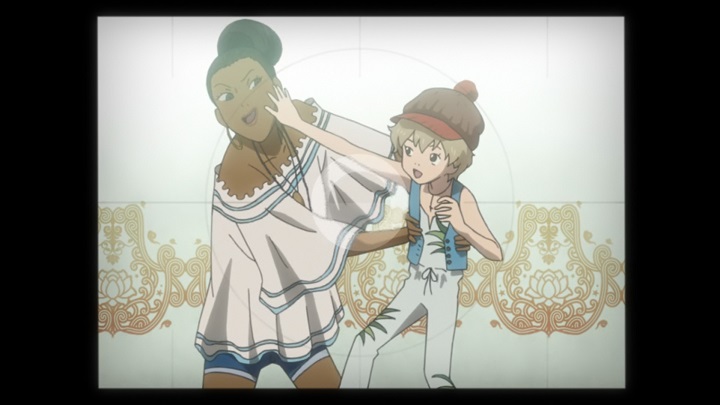
Little Family to be Found
And with that we come to the end of the review. This last section is a purely personal one, where I take off the reviewer hat and simply try to connect and explain my experience with a show. If that isn’t something you care about, if all you want is a score, then feel free to skip this section. But if you want try to understand me a bit more, and where I’m coming from with all this, then read on. And be warned! This is no holds barred spoiler territory. Read at your own risk if you haven’t watched Michiko & Hatchin!
I mentioned it before, but Found Family is one of my favorite themes in media. Between people finding love who once thought they didn’t deserve it, to those who have lost family finding purpose in a new one. They are the sorts of stories that I connect with the most, and think are truly beautiful. So I was really excited when Michiko & Hatchin was recommended to me as one such story, not to mention it came with a Latin American flair which I also like, see Megalo Box: Nomad. This is a culture that naturally lends itself to these sorts of stories, and Sayo Yamamoto is a proven director at this point. Surely it’ll scratch that itch… right? Sadly after 22 episodes, despite having a few standouts during its run, Michiko & Hatchin just… didn’t.
I was never able to really buy into their relationship. It never felt genuine to me. These two spend the entire show bickering and fighting, yelling and hitting each other. Fighting is normal in a family, sure, you can’t agree all the time. And having just met it makes sense that these two would need to come together a bit. In the early episodes, this is fine and the show works great. But as Michiko & Hatchin goes on and on, as they run into Satoshi Batista, and Atsuko, as we get these various other takes on family and relationships, our leads don’t really progress. Not until the final 4 episodes at least, where it then feels like it all comes at once. Rather then feeling like a gradual coming together, it becomes forced and stilted. And this extends to many other characters relationships to!
Satoshi Batista is probably the best example of this. In his relationships with Shinsuke and Hiroshi, we have both the best and the worst story in the show. With Shinsuke, these two are built up and communicate throughout the entire show. Through flashbacks we see how they came together, while during the events of the show we see their falling out, all of it culminating in Satoshi killing his best friend in the place they basically became brothers. It’s beautiful in its tragedy, how this life of crime changed and destroyed them both. But in Hiroshi… Satoshi spends most of the show chasing after him, looking for some kind of closure, only to never get it. Instead he dies in an alleyway after protecting Hatchin. You could argue that is the closure, since she’s Hiroshi’s daughter. But there’s not enough of a connection either way for it to truly work.
And that’s sort of how it goes for the entire show, and why I find myself so split on it. When Michiko & Hatchin gives a character the proper attention, like Shinsuke or Pepe Lima, the result is beautifully tragic. But for others it spends more time watching them wander around the countryside, ostensibly “bonding”, then it does showing us any actual progression in their relationship. I just don’t think I can call a show without any actual family until the very end a true Found Family experience. At least not one on the level of Tokyo Godfathers or any of my other favorite media.
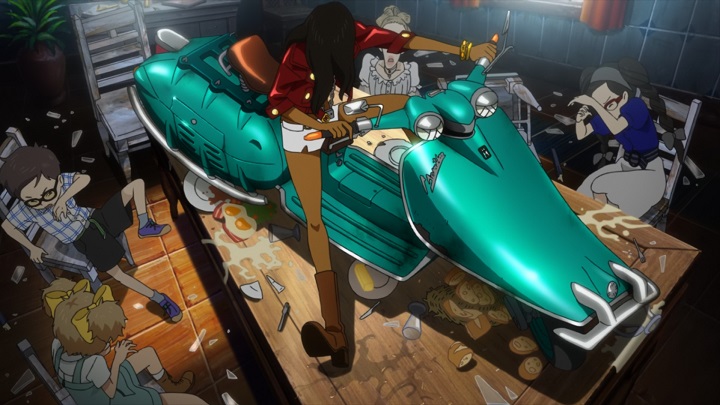
Conclusion
So all in all Michiko & Hatchin is a show with an incredible setting and sense for what it wants to be that stumbles in its execution. As a directorial debut, its certainly fine enough. You can see Sato Yamamoto’s dedication to not only the subject but the culture of what she’s trying to portray. She just doesn’t have enough experience to pull it off this early in her career. The characters feel stagnant for most of the shows run, while the story itself often feels meandering and purposeless. Michiko & Hatchin could easily have been half the length it is without losing very much of value I feel. Yet at the same time, it could easily fill another 11 episodes if it just had the attention and care to do so. Stuck in this awkward middle-ground, Michiko & Hatchin ends up achieving little more than light praise from me.
And with that we come to the end of another season of Throwback Thursday! Thank you everyone for reading. I apologize for how long this took, I really did just hit some writers block halfway through there. As such there will be no 1 week break between series like I usually take, we will pick up with our next show right away next thursday. But what is that next show you might ask? Well allow me to present to you, the 2003 Studio Bones original, created by Keiko Nobumoto and directed by Tensai Okamura, Wolf’s Rain! All I know is that this is some kind of Omegaverse werewolf thing, and that my friends are very split on it. Will it be any good? Will I turn into a furry from watching it? Find out next week, as we continue Throwback Thursday!

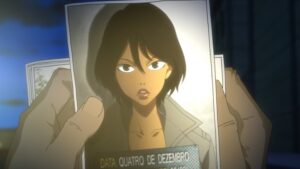
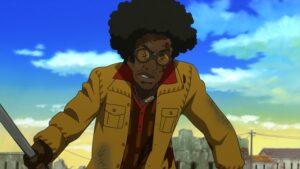
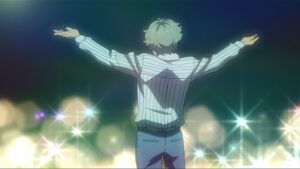
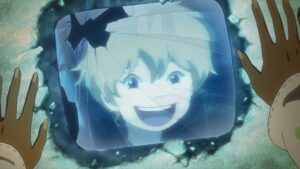
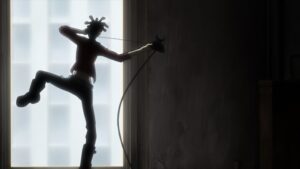
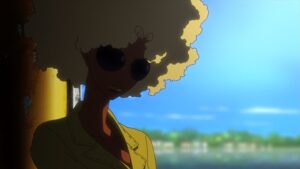
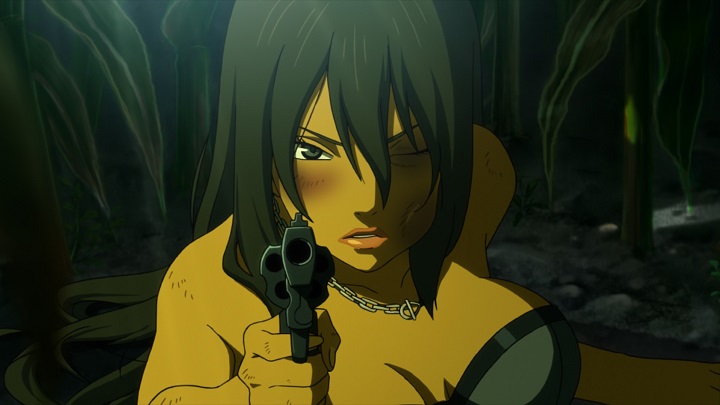
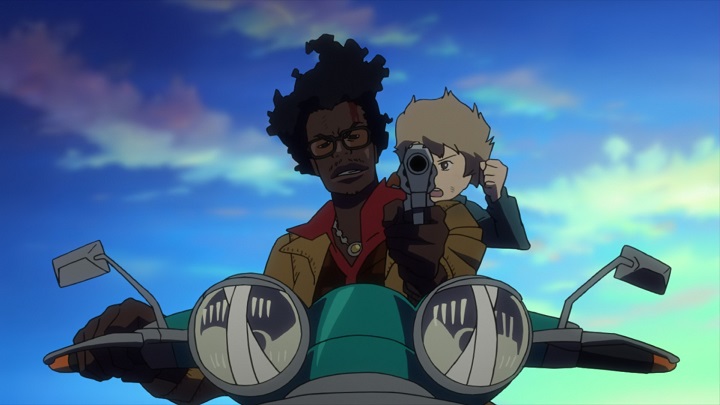
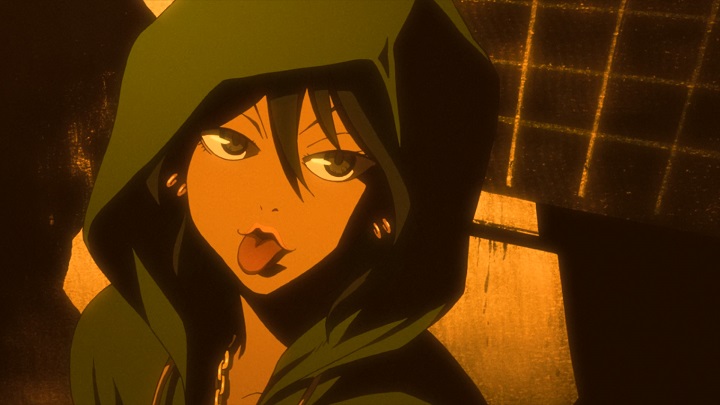
So excited to read your thoughts on Wolf’s Rain, its a top 10 anime of all time for me and I’m pretty sure I’ve voted for it every time its been in one of your polls (finally success! lol). In fact its an anime I got hyped for before it even came out given that it was carrying over a lot of key members of the Cowboy Bebop crew (main writer, character designer and composer at the very least) and watched it week to week as it aired until it got licensed and the fansubbers dropped it (alas, no Crunchyroll or the like back then).
I’m glad Wolf’s Rain finally won! I’ve been holding off on all the things on the list actually, waiting for the day any of them won.
Psgels rated this a lot higher back when it first came out. Eh, I admittedly wasn’t a fan of the show when I tried watching it. It’s nice to see different opinions on a work, though.
I remember having watched an episode of Wolf’s Rain at an anime club once. Curious to see what your thoughts on it are.
Still no Big O. Oh well. Wolf Rain is a memorable anime. Just remember to bring tissues when you start watching it.
One day I’m going to just watch it myself and write something lol. I’ve wanted to try it for so long but I keep holding out for it to win this.
Yeah Hiroshi sucked so much. For all the mystery he was basically a deadbeat dad and a fuckboi. They could have deleted this character entirely and it would have made the show much better